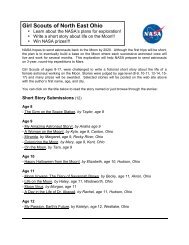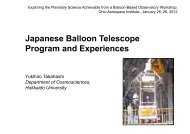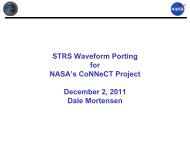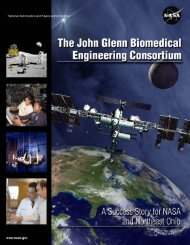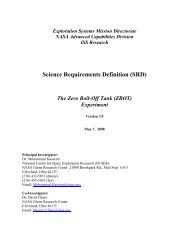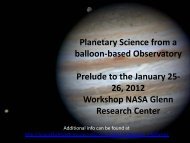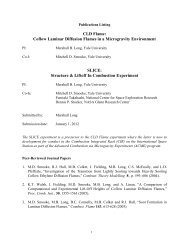Amusement Park Physics With a NASA Twist - Space Flight Systems ...
Amusement Park Physics With a NASA Twist - Space Flight Systems ...
Amusement Park Physics With a NASA Twist - Space Flight Systems ...
Create successful ePaper yourself
Turn your PDF publications into a flip-book with our unique Google optimized e-Paper software.
Newton’s First Law of Motion<br />
An object at rest will stay at rest and an object in motion will stay<br />
in motion with the same velocity—speed and direction— unless<br />
acted upon by a net external force. One can determine if a force<br />
is acting on an object: It moves if it was at rest; it changes speed<br />
if it was in motion; or it changes direction. Often it is a change of<br />
motion that makes a ride so thrilling. Consider riding in an<br />
automobile. If one closes his or her eyes while the car travels at<br />
a steady rate, he or she can hardly tell it is moving. But one can<br />
definitely feel sudden stops, starts, or sharp turns. <strong>Amusement</strong><br />
park rides capitalize on this by creating changes in motion to<br />
make the rides more exciting and interesting.<br />
If it is the change in motion that makes a ride so much fun,<br />
one must wonder what causes these changes. What makes a<br />
ride speed up, slow down, or take a sharp curve As Newton<br />
said, the answer is force.<br />
Forces<br />
A force, simply put, is a push or a pull. Forces exist<br />
everywhere. When one throws a ball at a target and tries to<br />
win a stuffed animal, his or her arm pushes on the ball until it<br />
leaves the hand; that is a force. When one presses the<br />
acceleration pedal of a bumper car, the car moves forward<br />
and the seat pushes on the rider’s body, another example of a<br />
force. Forces have both magnitude (size) and direction, as do<br />
displacement, velocity, and acceleration.<br />
Newton's First Law of Motion<br />
An object at rest will stay at rest<br />
and an object in motion will<br />
stay in motion with the same<br />
velocity—speed and direction—<br />
unless acted upon by an<br />
unbalanced external force.<br />
One can think of it this way. If a rider is in a bumper car traveling<br />
forward and someone bumps him or her from behind, the push<br />
or force is going in the same direction as the rider, so he or she<br />
would accelerate forward and speed up. If the rider gets a<br />
bump from the side, he or she may not speed up, but the car<br />
and the rider will change directions. In a head on collision the<br />
car may stop or it may bounce backwards, depending on the<br />
circumstances. In all these situations, the final outcome<br />
depends upon the amount of force and the direction of force.<br />
What do these examples have in common An outside force<br />
applied to an object causes the object to accelerate. This is<br />
explained by Newton’s second law of motion.<br />
Newton’s Second Law of Motion<br />
The greater the force on an object, the greater its acceleration,<br />
that is, F = ma, where F stands for force applied, a for<br />
acceleration, and m represents the mass of the object to<br />
which the force is applied.<br />
17<br />
<strong>Amusement</strong> <strong>Park</strong> <strong>Physics</strong> <strong>With</strong> a <strong>NASA</strong> <strong>Twist</strong><br />
EG–2003–03–010–GRC



